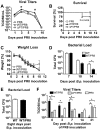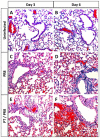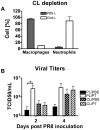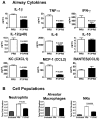Bordetella pertussis infection exacerbates influenza virus infection through pertussis toxin-mediated suppression of innate immunity
- PMID: 21533103
- PMCID: PMC3080395
- DOI: 10.1371/journal.pone.0019016
Bordetella pertussis infection exacerbates influenza virus infection through pertussis toxin-mediated suppression of innate immunity
Abstract
Pertussis (whooping cough) is frequently complicated by concomitant infections with respiratory viruses. Here we report the effect of Bordetella pertussis infection on subsequent influenza virus (PR8) infection in mouse models and the role of pertussis toxin (PT) in this effect. BALB/c mice infected with a wild-type strain of B. pertussis (WT) and subsequently (up to 14 days later) infected with PR8 had significantly increased pulmonary viral titers, lung pathology and mortality compared to mice similarly infected with a PT-deficient mutant strain (ΔPT) and PR8. Substitution of WT infection by intranasal treatment with purified active PT was sufficient to replicate the exacerbating effects on PR8 infection in BALB/c and C57/BL6 mice, but the effects of PT were lost when toxin was administered 24 h after virus inoculation. PT had no effect on virus titers in primary cultures of murine tracheal epithelial cells (mTECs) in vitro, suggesting the toxin targets an early immune response to increase viral titers in the mouse model. However, type I interferon responses were not affected by PT. Whole genome microarray analysis of gene expression in lung tissue from PT-treated and control PR8-infected mice at 12 and 36 h post-virus inoculation revealed that PT treatment suppressed numerous genes associated with communication between innate and adaptive immune responses. In mice depleted of alveolar macrophages, increase of pulmonary viral titers by PT treatment was lost. PT also suppressed levels of IL-1β, IL-12, IFN-γ, IL-6, KC, MCP-1 and TNF-α in the airways after PR8 infection. Furthermore PT treatment inhibited early recruitment of neutrophils and NK cells to the airways. Together these findings demonstrate that infection with B. pertussis through PT activity predisposes the host to exacerbated influenza infection by countering protective innate immune responses that control virus titers.
Conflict of interest statement
Figures







Similar articles
-
Pertussis toxin exacerbates and prolongs airway inflammatory responses during Bordetella pertussis infection.Infect Immun. 2012 Dec;80(12):4317-32. doi: 10.1128/IAI.00808-12. Epub 2012 Oct 1. Infect Immun. 2012. PMID: 23027529 Free PMC article.
-
Suppression of serum antibody responses by pertussis toxin after respiratory tract colonization by Bordetella pertussis and identification of an immunodominant lipoprotein.Infect Immun. 2004 Jun;72(6):3350-8. doi: 10.1128/IAI.72.6.3350-3358.2004. Infect Immun. 2004. PMID: 15155640 Free PMC article.
-
Pertussis toxin stimulates IL-17 production in response to Bordetella pertussis infection in mice.PLoS One. 2009 Sep 17;4(9):e7079. doi: 10.1371/journal.pone.0007079. PLoS One. 2009. PMID: 19759900 Free PMC article.
-
Investigating pertussis toxin and its impact on vaccination.Future Microbiol. 2015;10(2):241-54. doi: 10.2217/fmb.14.123. Future Microbiol. 2015. PMID: 25689536 Review.
-
Association of Pertussis Toxin with Severe Pertussis Disease.Toxins (Basel). 2019 Jun 27;11(7):373. doi: 10.3390/toxins11070373. Toxins (Basel). 2019. PMID: 31252532 Free PMC article. Review.
Cited by
-
The emergence of a suburban penalty during the 1918/19 influenza pandemic in Malta: The role of a marketplace, railway, and measles.PLOS Glob Public Health. 2023 Sep 1;3(9):e0002167. doi: 10.1371/journal.pgph.0002167. eCollection 2023. PLOS Glob Public Health. 2023. PMID: 37656666 Free PMC article.
-
[Clinical, laboratorial and radiographic predictors of Bordetella pertussis infection].Rev Paul Pediatr. 2014 Dec;32(4):292-8. doi: 10.1016/j.rpped.2014.06.001. Rev Paul Pediatr. 2014. PMID: 25510991 Free PMC article.
-
PTX Instructs the Development of Lung-Resident Memory T Cells in Bordetella pertussis Infected Mice.Toxins (Basel). 2021 Sep 8;13(9):632. doi: 10.3390/toxins13090632. Toxins (Basel). 2021. PMID: 34564636 Free PMC article.
-
[Complications of pertussis].Zhongguo Dang Dai Er Ke Za Zhi. 2019 Jul;21(7):713-717. doi: 10.7499/j.issn.1008-8830.2019.07.018. Zhongguo Dang Dai Er Ke Za Zhi. 2019. PMID: 31315774 Free PMC article. Review. Chinese.
-
Efficient neutrophil extracellular trap induction requires mobilization of both intracellular and extracellular calcium pools and is modulated by cyclosporine A.PLoS One. 2014 May 12;9(5):e97088. doi: 10.1371/journal.pone.0097088. eCollection 2014. PLoS One. 2014. PMID: 24819773 Free PMC article.
References
-
- "Pertussis: Outbreaks.". 2010. Pertussis Report November 30, CDC. n.d. Web. http://wwwcdcgov/pertussis/outbreakshtml#ca.
-
- Lundeen A, Horton M. Whooping cough epidemic may be worst in 50 years. 2010. California Department of Public Health (CDPH)
-
- Wesley AG, Windsor IM. Viral infections in clinical pertussis. S Afr Med J. 1983;64:577–578. - PubMed
-
- Sawal M, Cohen M, Irazuzta JE, Kumar R, Kirton C, et al. Fulminant pertussis: a multi-center study with new insights into the clinico-pathological mechanisms. Pediatr Pulmonol. 2009;44:970–980. - PubMed
Publication types
MeSH terms
Substances
Grants and funding
LinkOut - more resources
Full Text Sources
Medical
Miscellaneous

